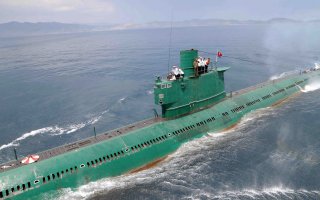North Korea's Mini Submarines Are Simply Terrifying
North Korea’s submarine fleet – one of the world’s largest – personifies some of the defining features of the North Korean military as a whole.
North Korea’s submarine fleet – one of the world’s largest – personifies some of the defining features of the North Korean military as a whole. As a subset of the larger submarine fleet, North Korea’s many coastal and mini-submarines, in particular, stand out as intriguing encapsulations of some of the North Korean military’s important characteristics.
The Quantity Problem
North Korea’s Korean Peoples’ Army (KPA) is characterized largely by a quantity over quality dynamic. The KPA is large, with nearly 1.3 million active-duty soldiers currently underarms, and boasts an advantage in numbers in some important areas over its Southern counterpart, including in artillery pieces, multiple rocket launchers (MRLs), and tanks. This advantage in overall capacity is marred by a qualitative deficiency when compared to both the South Korean and American militaries, however, with the KPA fielding largely outdated equipment whose capability is lacking in comparison to the equipment fielded by the more modern militaries of its adversaries.
Asymmetric Capabilites
To overcome this qualitative inferiority, North Korea has prioritized the pursuit of asymmetric military capabilities, with the U.S. Department of Defense assessing that the DPRK focuses its efforts on areas where it believes it may have the potential for some comparative advantage over its rivals. This type of strategic thinking is not new for North Korea, with a similar approach to defense modernization having existed since the early 1960s when North Korea promulgated a new defense policy known as the Four-Point Military Guidelines, which included an emphasis on military capabilities that provided the greatest strategic benefit at the lowest possible cost in keeping with the country’s financial and resource constraints. This strategic logic has contributed to North Korea’s decision to pursue its nuclear weapons and ballistic missile programs, as well as to its focus on such capabilities as special operations forces and cyber tools.
North Korea’s submarine fleet reflects both the overriding dynamic of the KPA as well as its asymmetric focus. The DPRK’s submarine fleet – like the KPA as a whole – is large, with top-end estimates placing the total fleet at over 80 vessels, while other estimates gauge its total strength to be closer to 70 boats. The fleet is comprised primarily of aging vessels, however, and is made up of a combination of conventional attack submarines, coastal submarines, mini-subs, and an emerging ballistic missile submarine capability.
North Korea’s conventional attack submarine fleet is made up of Soviet Romeo-class submarines, the first of which was acquired by North Korea in the 1970s. In addition, North Korea operates a single Gorae-class ballistic missile submarine and is reportedly approaching completion of a second, dedicated ballistic missile submarine that has been dubbed the Sinpo-C.
The Mini Submarine Threat
The remainder of North Korea’s submarine fleet is comprised of a mix of coastal and mini-submarines, including roughly 40 Sang-O- and Sang-0 II-class coastal submarines and approximately 20 Yugo- and Yono-class mini-submarines. As with submarines more generally, these vessels fit the asymmetric mold of North Korean military prioritization.
Like their conventional brethren, North Korea’s coastal and mini-submarines lack capability when compared on a one-to-one basis with the vessels of its primary adversary navies, but are likely to still pose a threat to those vessels, ports, and enemy shipping when deployed as a swarm. Unlike its larger conventional attack counterparts, however, North Korean coastal and mini subs are not capable of conducting extended patrols, and are limited to a coastal defense role.
The above limitations notwithstanding, these submarines remain a potential threat. It is believed that a North Korean mini-sub was responsible for the 2010 sinking of the ROK Navy corvette Cheonan that left 46 South Korean sailors dead, demonstrating the danger posed by these vessels.
In addition, coastal and mini-submarines provide North Korea utility and flexibility that reflects the larger North Korean desire for strategic value in its military capabilities. In addition to their potential for use against enemy ships, coastal and mini-submarines are well suited for use as infiltration vessels for the insertion of North Korean specials forces operatives. A North Korean coastal submarine was, for example, used in 1996 to insert special forces operatives into South Korea, which kicked off a series of firefights and a day’s long manhunt.
North Korea operates a Special Operations Force of roughly 200,000 highly capable soldiers trained for reconnaissance and sabotage operations, and which would likely play an important role in a major conflict on the Korean Peninsula as rear-area infiltrators. North Korea maintains a number of capabilities for deploying its special operations soldiers, including coastal and mini-submarines operated by the Reconnaissance General Bureau, the country’s military intelligence organization. Within the RGB, the First Bureau – responsible for escort operations – is believed to operate a number of the vessels, as is the Maritime Department of the Second Bureau.
North Korea’s coastal and mini-submarines are an interesting reflection of the KPA as a whole. They are numerous, and as such pose a threat, but are themselves qualitatively limited. They are also an example of the asymmetric focus on the part of the North Korean military that has prioritized such a line of development, while their added utility as infiltration vessels also demonstrates the North Korean emphasis on strategic value in its military capabilities.

